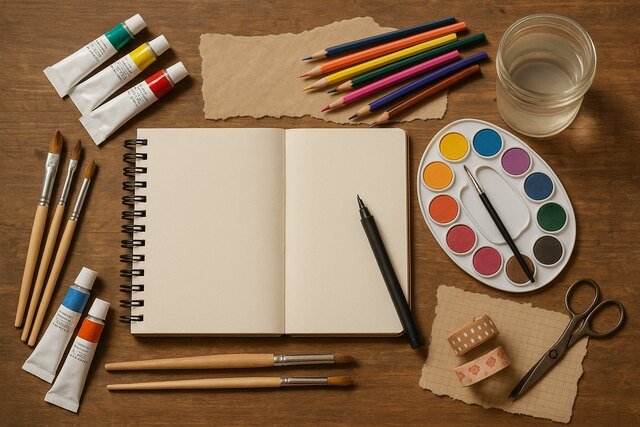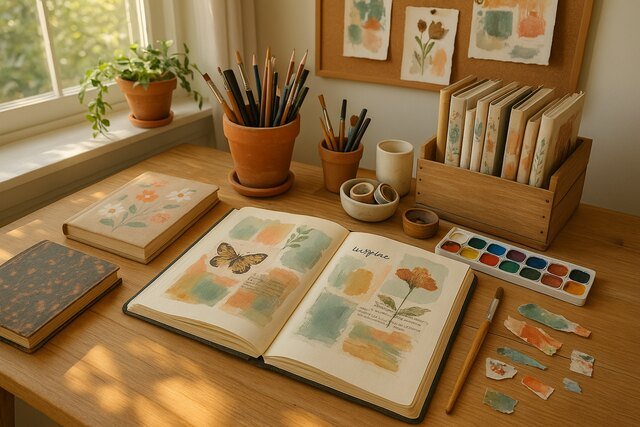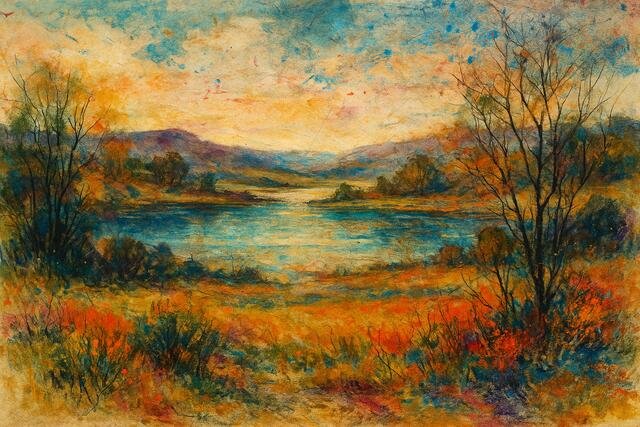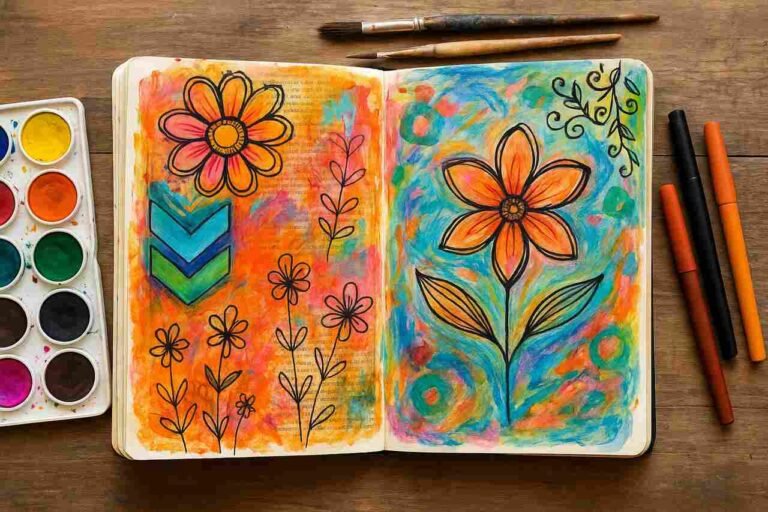Introduction
Art journaling is a powerful practice that combines visual creativity with personal reflection. It merges the worlds of art and writing, allowing individuals to express emotions, capture experiences, and document personal growth. Whether you are an artist, a writer, or someone seeking mindfulness, art journaling provides a tangible way to explore your inner world through color, texture, and text. This creative process not only enhances self-awareness but also nurtures relaxation, imagination, and resilience.
Gather Essential Art Journaling Supplies

The first step in starting an art journal is to gather the right materials that support your creative flow. A sturdy sketchbook or mixed media journal serves as the foundation for your artwork. Choosing high-quality paper ensures your pages can handle watercolors, inks, and collages without tearing. Essential tools include pens, pencils, brushes, and adhesives, each contributing to different artistic effects.
Consider the mediums you enjoy most before purchasing supplies. Watercolors and acrylics offer vibrant color palettes, while markers and gel pens add fine detail and precision. Adhesives and washi tapes help in layering textures, giving depth to journal spreads. For beginners, starting with basic supplies and gradually experimenting with different materials leads to more authentic artistic expression.
Art journaling materials vary based on personal style, but understanding their attributes helps in building a sustainable toolkit. Using archival-quality paper prevents fading, while acid-free adhesives protect artworks from deterioration. Over time, collecting specialized materials like stencils, stamps, and embossing powders adds uniqueness to every journal page.
Choose Quality Paper for Durability
Paper quality determines the longevity and finish of your art journal. Opt for 120 to 200 gsm paper for mixed media or watercolor journals to prevent warping. Textured papers add tactile interest, enhancing sensory engagement while creating.
Organize Tools for Efficient Workflow
Storing supplies in clear containers or drawers improves accessibility and saves time. Labeling compartments for brushes, markers, and tapes ensures a smooth creative process and reduces clutter.
Common Art Journaling Supplies and Their Uses
| Supply Type | Function | Ideal For |
| Sketchbook | Base surface for artwork | All journaling styles |
| Acrylic Paints | Bold, opaque effects | Abstract layers |
| Gel Pens | Fine details and outlines | Lettering and doodles |
| Adhesives | Collage and layering | Mixed media spreads |
Create a Dedicated Art Journaling Space

Establishing a personal creative space enhances focus and comfort while journaling. A well-organized area fosters routine and signals your brain to enter a creative mindset. Choose a quiet corner with natural light and enough workspace for spreading out materials.
Ensure your workspace accommodates easy cleanup and accessibility. Use a desk mat, aprons, and paper towels to manage spills. Keeping supplies within reach promotes uninterrupted flow and encourages daily journaling habits. Adding inspiration boards or pinned artworks can spark ideas during creative blocks.
The environment influences emotional tone and artistic output. Incorporating calming elements like plants, candles, or music transforms your journaling space into a sanctuary. Whether small or spacious, the key lies in personalizing the area to reflect your artistic identity.
Optimize Lighting for Artistic Accuracy
Natural lighting enhances color perception, while daylight bulbs maintain clarity during evening sessions. Avoid harsh overhead lights to prevent glare on glossy mediums.
Maintain Comfort and Ergonomics
Use adjustable chairs and stable tables to support long journaling sessions. Proper posture minimizes strain and supports sustained creativity.
Develop a Consistent Art Journaling Routine
Consistency cultivates skill, discipline, and emotional connection to the journaling process. Establishing a routine helps transform journaling into a mindful ritual rather than a sporadic hobby. Setting aside specific times daily or weekly reinforces commitment and creative continuity.
Start small with short sessions to avoid overwhelm. Over time, lengthen your creative practice as comfort grows. Tracking progress helps in observing artistic evolution and emotional themes appearing through your pages. Consistency not only improves artistic technique but also deepens self-understanding.
Routines foster a psychological rhythm that links creativity to self-care. As you revisit your journal, you build a visual narrative of your emotions, growth, and inspirations. The act of showing up regularly becomes a gentle reminder of resilience and self-expression.
Set Realistic Goals for Motivation
Define achievable objectives such as completing one page per week. Incremental progress nurtures satisfaction and prevents creative burnout.
Incorporate Reflection After Each Session
After journaling, take a few minutes to observe patterns, color choices, or emotional shifts. Reflection enhances awareness and promotes intentional artistry.
Experiment with Mixed Media Techniques

Exploration lies at the heart of art journaling. Using mixed media techniques introduces texture, dimension, and surprise into your pages. Combining paint, collage, ink, and fabric generates rich, layered compositions full of visual storytelling.
Experimenting with diverse materials stimulates new ideas. Try blending watercolor washes with pen outlines or integrating printed images into painted backgrounds. These combinations create depth and movement, making your journal visually engaging and emotionally expressive.
Creative experimentation also builds artistic confidence. By embracing imperfection and playfulness, you cultivate freedom from rigid outcomes. Each mistake becomes a new artistic discovery that enhances your style and individuality.
Use Layering to Add Depth
Start with broad color backgrounds, then build layers using collage, texture paste, or stamped motifs. Layering encourages curiosity and multidimensional thinking.
Integrate Text for Emotional Expression
Incorporate handwritten quotes, affirmations, or journal entries into your visuals. Text bridges emotion and art, transforming pages into deeply personal reflections.
Explore Thematic Prompts for Inspiration
Creative prompts guide your journaling when inspiration feels low. Themes like growth, healing, or dreams stimulate ideas and emotional exploration. Prompts serve as gentle frameworks, helping you connect imagery with meaning.
Using prompts can also refine storytelling within your art journal. Visual themes build cohesion across pages, reflecting ongoing life narratives. You can base prompts on emotions, seasons, memories, or artistic challenges, adapting them to your personal journey.
Thematic prompts encourage experimentation while maintaining focus. They introduce purpose to each entry and inspire consistency in your artistic evolution.
Use Emotion-Based Prompts for Self-Awareness
Identify feelings such as joy, anxiety, or gratitude, and translate them into colors and shapes. Emotional journaling transforms internal experiences into creative outputs.
Create Monthly Challenge Lists
Compile lists of prompts for 30-day journaling challenges. This structure helps maintain creativity and accountability through sustained practice.
Example Prompts for Thematic Art Journaling
| Theme | Prompt Example | Artistic Focus |
| Growth | Paint a seed sprouting | Transformation |
| Healing | Use blue tones and texture | Emotional release |
| Dreams | Collage night imagery | Imagination |
| Gratitude | Illustrate daily blessings | Positivity |
Document Personal Stories Through Visual Narratives
An art journal can become a visual autobiography, capturing life stories in symbolic and creative ways. Using images, colors, and words, you can chronicle memories, transitions, and emotions without constraints.
Storytelling through art builds emotional connection and authenticity. Personal moments like travels, relationships, or milestones can be abstractly represented using symbolic motifs. A photo glued beside a painted landscape or a handwritten letter overlaying textured color can immortalize emotions that words alone cannot convey.
Visual storytelling fosters resilience and memory retention. It allows individuals to revisit experiences from new perspectives, observing growth and healing over time. Your journal becomes both a mirror and a timeline of self-evolution.
Combine Imagery with Symbolism
Select symbols that represent feelings or moments such as birds for freedom or keys for new beginnings. Symbolism adds depth and narrative coherence.
Include Photographs and Memorabilia
Attach photos, receipts, or tickets to visually anchor experiences. These tangible elements reinforce memory and meaning within your journal.
Preserve and Share Your Art Journal
Preservation ensures that your creative efforts withstand time. Protect finished pages using fixative sprays or protective sheets. Store journals in dry, cool environments to avoid fading or moisture damage. Digital archiving through photography or scanning allows for easy sharing and backup.
Sharing your art journal can inspire others while fostering community connection. Online platforms, art groups, and workshops create opportunities to exchange ideas and techniques. Displaying pages publicly can also motivate continuous creation and refinement.
Preserving your art is a way of honoring your creative journey. Every page reflects personal history, emotion, and imagination, a legacy of inner exploration and artistry.
Use Archival Methods for Longevity
Apply UV-protective sprays and acid-free covers. Regularly inspect journals for wear and address deterioration promptly.
Share Your Work Mindfully
When sharing online, protect your privacy by blurring personal text or watermarks. Focus on showcasing techniques and inspiration rather than personal details.
Conclusion
Art journaling unites creativity and mindfulness in one transformative practice. It empowers individuals to externalize emotions, experiment with techniques, and record personal evolution through visual storytelling. By gathering the right materials, setting up an inspiring workspace, and maintaining a consistent routine, anyone can develop a meaningful art journaling habit. Each page becomes a reflection of inner life, colorful, honest, and endlessly evolving. The journey is not about artistic perfection but authentic expression, making art journaling a lifelong companion for creativity and self-discovery.
Explore more insightful and valuable content on our blog journalingtechniques! Stay updated with helpful tips, expert advice, and in-depth articles that enhance your knowledge.
FAQ’s
Start with simple supplies and focus on expressing feelings rather than technical skill. Art journaling values authenticity over perfection.
A5 or 8×10-inch journals are ideal for beginners, large enough for expression but small enough to manage comfortably.
Yes, digital tools like Procreate or Canva allow similar creativity. However, physical journaling offers tactile engagement that enhances mindfulness.
Consistency matters more than frequency. Weekly or biweekly sessions help sustain practice without pressure.
Mistakes are part of the process. Embrace them as creative opportunities, layer over, collage, or transform them into new designs.
Use lockable drawers, digital encryption for scans, or create coded entries if your journal contains sensitive content.

